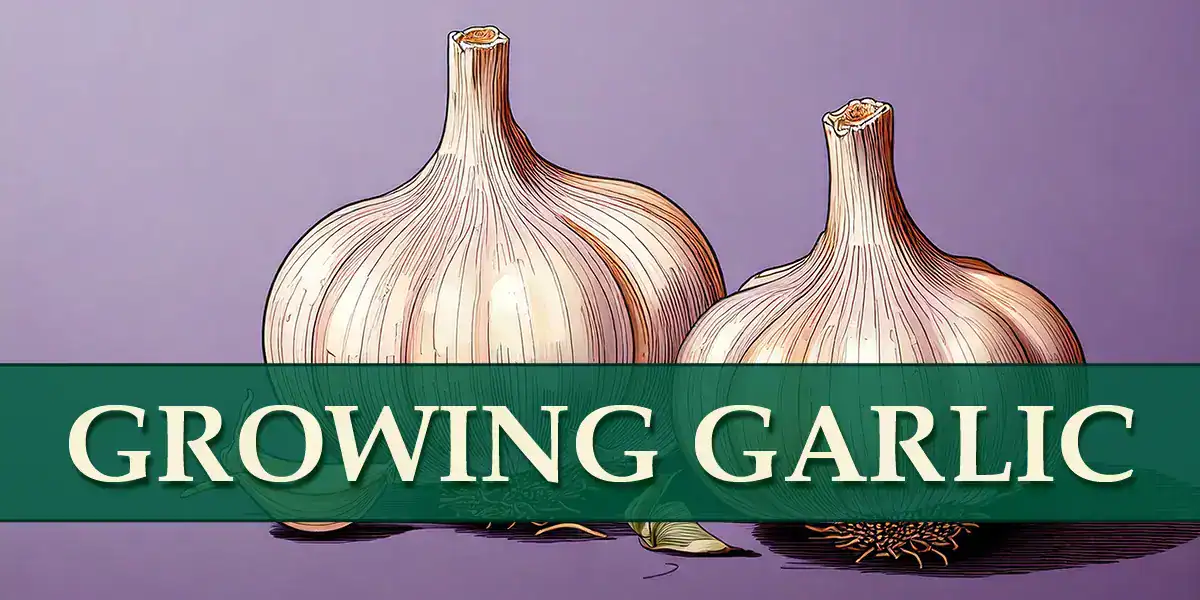Garlic (Allium sativum) was first cultivated over 5,000 years ago in regions of modern-day Kyrgyzstan, Tajikistan, and Uzbekistan. Ancient trade routes introduced it to the Mediterranean, Africa, and eventually the Americas.
The ancient Egyptians believed it boosted strength and stamina, and fed it to the builders of the pyramids. It must have worked; they constructed the pyramids in record time. Imagine all that garlicky sweat under the blistering August sun!
Europeans during the Middle Ages wore garlic around their necks to ward off the plague (it didn’t). In Eastern Europe, it supposedly repelled evil spirits, witches, and the undead.
Magical powers aside, garlic is now a foundational flavor in many cuisines — Italian, Chinese, Indian, Middle Eastern, and Latin American — valued for its pungency, versatility, and ability to enhance other ingredients. It’s one of the most widely used seasonings in the world.

This Halloween vampire prefers candy corn to pungent garlic cloves.
Growing Garlic in SoCal
Southern California can be an excellent place to grow garlic, but you’ll need to work with the region’s mild winters and sometimes unpredictable rainfall.
Climate Fit
- Winter Chill: Garlic benefits from a cold period (“vernalization”) to develop large bulbs. In Southern California’s mild winters, you’ll get enough chill for many varieties, but hardneck garlic (which needs more cold) may underperform versus softneck types.
- Dry Summers: The hot, dry summer finish is ideal for curing garlic after harvest and helps prevent rot.
- Long Growing Season: Mild winters and warm springs mean you can grow garlic with fewer frost risks.
Best Varieties for SoCal
- Softneck types (Artichoke and Silverskin varieties) do exceptionally well — they’re less dependent on deep winter cold.
Popular Choices
- California Early (early maturing)
- California Late (stores longer)
- Italian Late
- Inchelium Red (mild flavor)
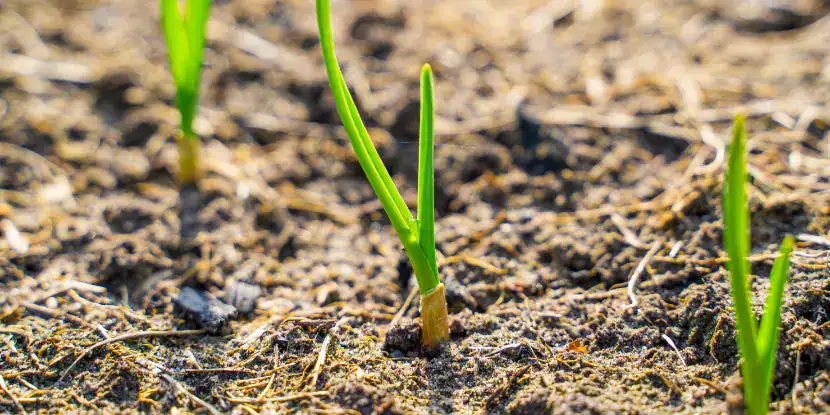
Young garlic plants sprouting in the garden.
Steps for Planting Garlic
Timing
- Plant in fall (6–8 weeks before the ground freezes in colder climates; October–December in Southern California).
- This allows roots to develop over winter before top growth in spring.
Preparation
Garlic is vegetatively propagated, meaning you plant cloves, not seeds. Each clove will grow into a new bulb genetically identical to the parent plant.
- Select large, healthy cloves. Larger cloves produce bigger bulbs.
- Separate cloves just before planting to prevent them from drying out.
- Garlic likes loose, well-drained, fertile soil (pH 6–7). Add compost or well-rotted manure; avoid planting garlic in heavy clay soils.
Planting
- Plant cloves pointy side up, about 2 inches deep (3 inches in colder climates).
- Allow 4–6 inches between cloves in rows 12–18 inches apart.
- Mulch with straw, leaves, or shredded bark to regulate temperature and suppress weeds.
- Water immediately after planting to settle the soil.
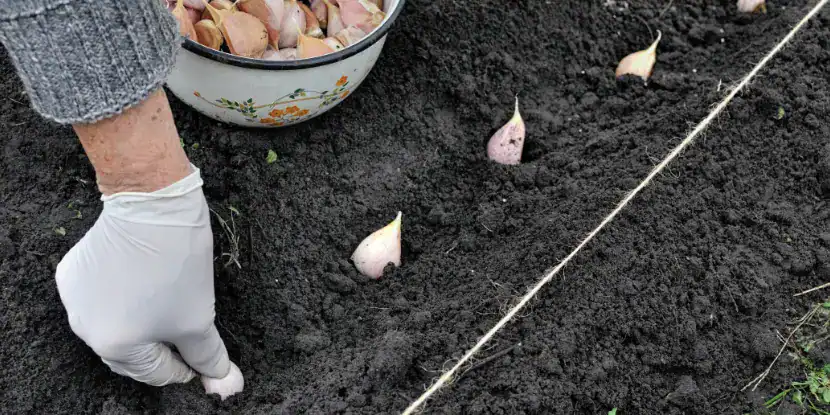
A gardener plants a row of garlic cloves.
Garlic Plant Care
Temperature
- Garlic grows best in cool to moderate climates, with temperatures between 55 °F and 75°F (13 °C and 24°C).
- Temperatures consistently above 85°F (29°C) can result in smaller bulbs and lowered resistance to disease.
Watering
- Garlic needs consistent moisture but should not be waterlogged.
- Planting in raised beds or adding organic matter can help improve drainage.
- Water deeply once a week if there is no significant rainfall.
- Stop watering 2–3 weeks before harvest to prevent rot and help curing.
Fertilizer
- Apply a balanced fertilizer with equal parts nitrogen, phosphorus, and potassium at planting time.
- Avoid high-nitrogen fertilizers that encourage garlic bulbs to split.
Mulching
- Mulch conserves soil moisture and suppresses weed growth.
- Use a 1–2-inch layer of organic mulch like straw, leaves, or grass clippings.
- This will also help regulate soil temperature.
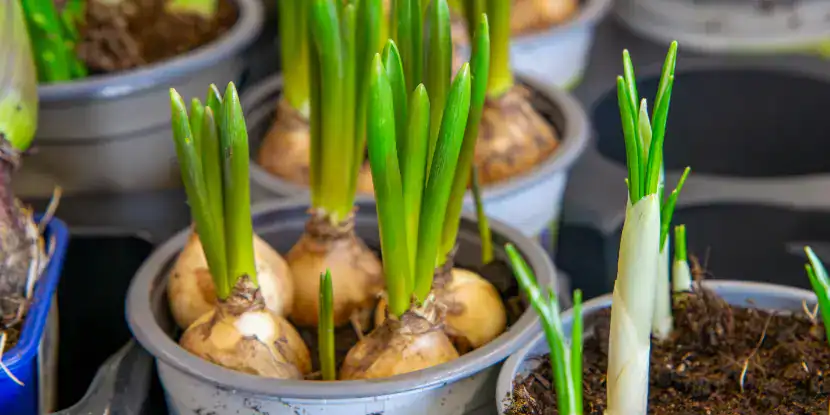
Healthy garlic plants growing in containers.
Pests & Diseases
Pests
- Onion Thrips: Tiny insects that feed on leaves, resulting in silvery streaks. Remove plant debris, use reflective mulch, and encourage beneficial insects.
- Nematodes (Stem and Bulb Nematode): Microscopic worms that cause distorted, rotting bulbs. Plant certified nematode-free garlic and rotate crops for 4+ years.
- Leafminers: The larvae tunnel inside leaves, weakening plants. Remove infested leaves and use floating row covers early in the season.
Diseases
- White Rot (Sclerotium cepivorum) causes yellowing leaves, rotting roots, and small bulbs, and can persist in soil for decades. Select disease-free planting stock, avoid infected soil, and rotate crops.
- Rust (Puccinia allii): Orange pustules on leaves, reducing photosynthesis. Remove infected leaves, improve airflow, and avoid overhead watering.
- Basal Plate Rot: A fungus that rots the base of the bulb. Plant in well-drained soil and avoid mechanical injury to cloves.
Harvesting
- Garlic is typically ready to harvest in late summer or early fall, around six months after planting.
- The tops of the plants will yellow and fall over, indicating that the bulbs are ready for harvest.
- Gently loosen the soil around the bulb and carefully lift it from the ground.
- Brush off excess dirt and lay the harvested garlic in a dry, well-ventilated area to cure for 2–3 weeks.
- Once the garlic has cured, trim off any remaining roots and cut back the stems to about an inch above the bulb.
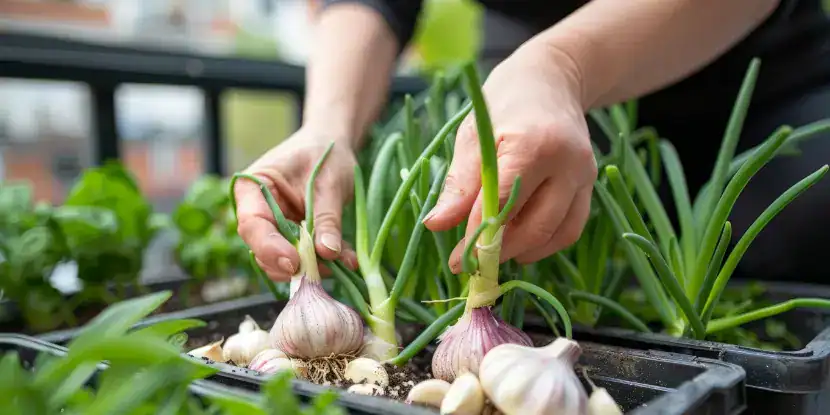
We’re not sure what this gardener is doing. It’s too early to harvest! Influencing on Instagram, maybe?
Storing
- Store cured garlic in a cool, dark place with good air circulation. Avoid storing garlic in plastic bags, which can lead to rot.
- If stored properly, garlic will keep for several months. Check on your stored garlic regularly and remove cloves showing signs of decay.
- To preserve garlic for longer periods, consider freezing or pickling it. Frozen garlic should be used within 6 months, while pickled garlic can last up to a year.
Using Garlic
Garlic is a versatile ingredient that can enhance the flavor of many dishes. Here are some tips for using garlic in your cooking:
- For the best results, crush or mince raw garlic before adding it to dishes. This helps release its potent flavor and aroma.
- Roasting whole heads of garlic can produce a milder, nuttier flavor than raw garlic.
- Lightly sauté minced or sliced garlic in oil for a quick infusion of garlicky flavor before adding it to your dish.
- When including garlic in soups or stews, add it towards the end of cooking to retain its flavor and avoid burning it.
- If a recipe calls for garlic and onions, chop and cook the onions first before adding the garlic. Onions take longer to cook and can burn the garlic if added simultaneously.
- Place cloves in a metal bowl and cover with another bowl to remove the skin from fresh garlic. Shake vigorously for a few seconds, and the skins will loosen.
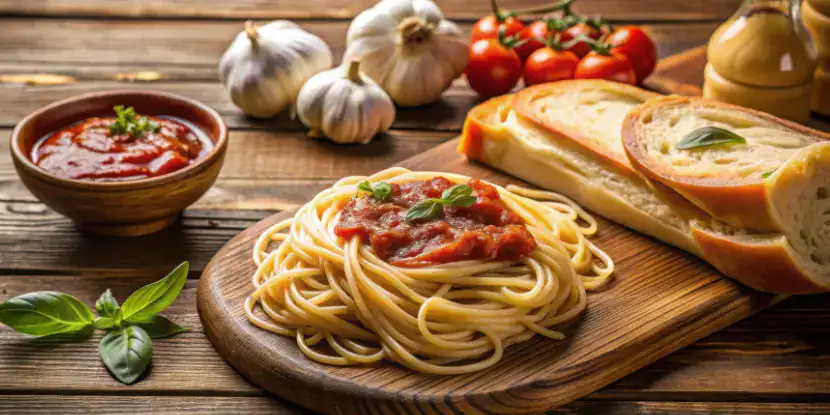
Marinara sauce without garlic? Perish the thought!
Garlic as a Companion Plant
Did you know garlic is a companion plant that can benefit other plants when grown alongside them?
- Garlic can repel pests such as aphids, beetles, and even certain types of nematodes.
- It can also attract beneficial insects like ladybugs and bees to your garden.
- When planted near roses or fruit trees, garlic can help prevent diseases and fungal infections.
- Garlic can improve the flavor and growth of certain plants, such as tomatoes and peppers.
- It’s a natural deterrent for larger animals like rabbits and deer.
Plant it between your other plants or around the perimeter of your garden. You can also make a garlic spray of blended cloves and water.
Garlic can also enrich the soil. Left to decompose, it releases sulfur compounds that act as a natural fertilizer.
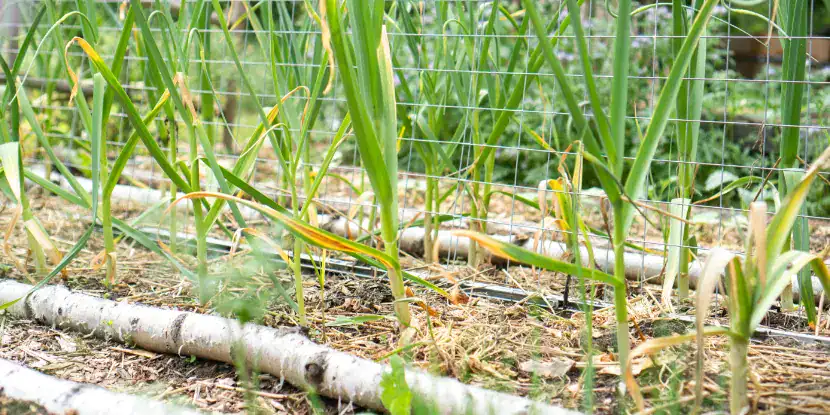
Garlic is a superstar companion plant. Here, cucumber vines will reap the benefits.
FAQs: Growing Garlic
Q: How long does it take to grow garlic?
Garlic generally takes about 8 to 9 months from planting to harvest, depending on the variety and the growing conditions.
Q: When is the best time to plant garlic?
The best time to plant garlic is in the fall, typically a few weeks before the first frost. This allows roots to establish before winter.
Q: How deep should I plant garlic cloves?
Plant garlic cloves 2 to 3 inches deep, with the pointed side facing up. Space the cloves about 6 inches apart.
Q: Should I fertilize garlic during its growth?
Yes, garlic benefits from nutrient-rich soil. Apply a balanced fertilizer or compost during planting and again in the spring as growth accelerates.
Q: How do I know when garlic is ready to harvest?
The leaves will turn yellow or brown and die back, usually in late spring or summer.
Q: Can I grow garlic in containers?
Yes. Use a pot with good drainage and ensure the soil stays moist but not soggy.
Q: What type of soil is best for garlic?
Garlic thrives in well-draining, loose soil with a high organic content and a pH between 6.0 and 7.5.
Q: How can I store harvested garlic?
Store garlic in a cool, dry, dark place with good ventilation. Avoid refrigeration, which can cause sprouting. Properly cured garlic can last for several months.

